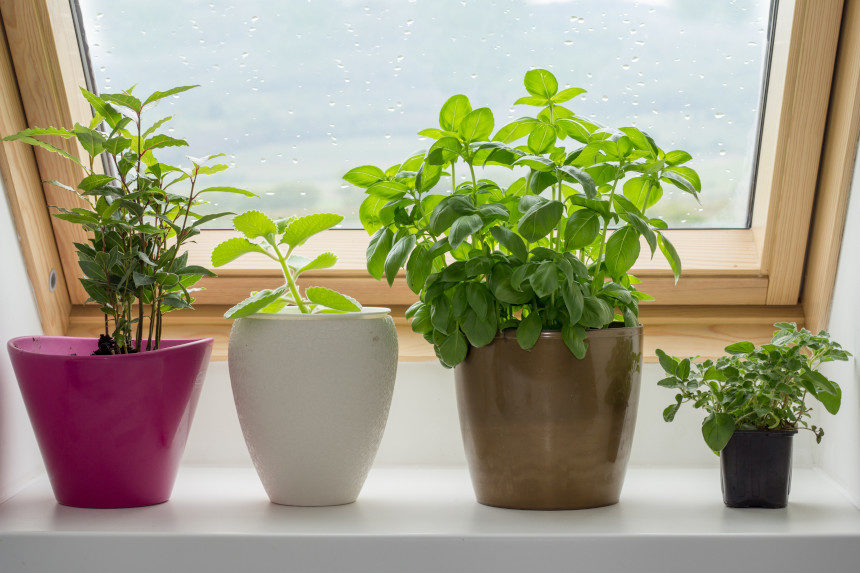If you browse too many lifestyle blogs and stumble upon enough viral “life-hack” videos, you might be pining for a lush indoor Garden of Eden of your own as the weather turns colder. But can you really regrow your kitchen scraps into new carrots and onions? Is it possible to grow a tomato indoors?
What is possible and what is worthwhile are not always the same. The good news is that you can create the thriving kitchen (or mezzanine) garden of your dreams, producing edible plants and herbs all winter long. Select your indoor edibles wisely, though. Unless you’ve got a bona fide greenhouse, forget about tomatoes.
Plenty of delicious options for kitchen gardening — that you might not have even considered — will thrive as long as you have a window. Assess your lighting situation (honestly!), and see what you should be growing in your kitchen this winter.
Low-light: You’re working with North-facing or otherwise encumbered windows. Sunlight is completely indirect or direct for only an hour or so. There is hope for you beyond growing a sad philodendron.
Medium-light: Your kitchen windows face East or West. You get a few hours of direct sunlight each day, and you might be surprised at what you can cultivate in a kitchen window box.
High-light: You have giant South-facing windows or skylights that let six or more hours of direct sunlight into your kitchen each day. You’re one of the lucky ones with big indoor-gardening potential.
(Note: these rough guidelines apply to kitchen gardeners residing in the northern hemisphere, since the sun’s direction is opposite in the southern hemisphere.)
Low-light:
It’s a rather dim existence in your kitchen, but that shouldn’t stop you from making the most of it. The first thing you should do is grow some Thai basil. This stuff loves the shade, unlike its sun-soaking cousins. If you pick up a bunch of Thai basil at your local international market and put it in a glass of water near the window (like cut flowers), it might even grow roots! Transfer the rooted plants to a pot with soil and enjoy fresh spicy basil leaves in your curries all winter.
As long as your windowsill sees some direct sunlight, you can also get into the business of growing greens. Some flavorful greens that will do well in low-light are sorrel and arugula. Spread seeds over a pot or window box filled with good dirt, cover them lightly, and keep it moist until they sprout. You can cut the leaves early (after two or three weeks) for a microgreens harvest, or thin the plants to a few inches apart and pick them after they’ve matured.
For an easy addition to salads and sandwiches, grow some sprouts. Since the sprouts you’ll harvest have only just germinated, lighting won’t be an issue. Procure some organic seeds (alfalfa, beans, broccoli, radish, etc.) and make a “sprouting jar” using The Micro Gardener’s easy tutorial.
Medium-light:
With a bit more direct sunlight, your options for indoor edible gardening open up considerably. To start, you can grow a luscious and convenient herb garden to use in all of those winter soups and roasts you have planned. Cilantro, parsley, mint, and oregano will all do well potted by a window (grow your mint separately so it doesn’t take over).
For rosemary and sage, you might see better results if you start plants in containers outside in the spring or summer and bring them in before frost. While they might not thrive indoors, you should be able to keep them growing well enough to harvest occasional stems.
As so many bloggers have reported, you can indeed regrow your green onions from the bulbs after you’ve used the rest (place them in moist dirt, not plain water). You can also regrow lettuce, ginger, and garlic in the same way. After you’ve chopped the lettuce leaves off, place the end butt-down halfway in moist soil. For ginger, bury a chunk with the buds facing upward. Plant a garlic clove that has sprouted some green to get a whole new bulb. Of course, you can purchase seeds from an online dealer to grow more varieties of these crops as well. (Don’t bother futzing with the scraps of carrots and turnips. These root vegetables are better left for outdoor growing or purchasing at the market.)
High-light:
The envy of us all: you big bright kitchen-havers. With enough daily direct sunlight, you can practically replicate the conditions for outdoor gardening. Plant some small pepper plants — like chiles, habaneros, or mini sweet bell peppers — immediately.
You are also in a good position to turn your kitchen into a tropical paradise with some citrus trees. Lemons, limes, and oranges, in many different kinds of full-size and dwarf varieties, could fill your kitchen with foliage and fragrancy.
Don’t go nuts with the tropical fruit cultivation, though. Growing an avocado tree from a pit will almost certainly yield no fruit, and regrowing your pineapple tops could take years.
But you can certainly count on lots of basil, kale, lettuce, and spinach. If you’re just dying for a homegrown tomato in February, and you have a giant kitchen, then I suppose no one can stop you.
Featured image: Carlos Amarillo/Shutterstock
Become a Saturday Evening Post member and enjoy unlimited access. Subscribe now



